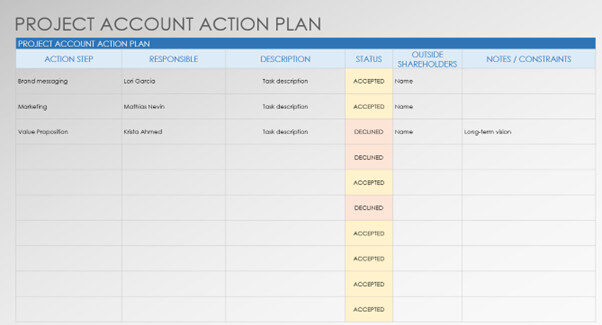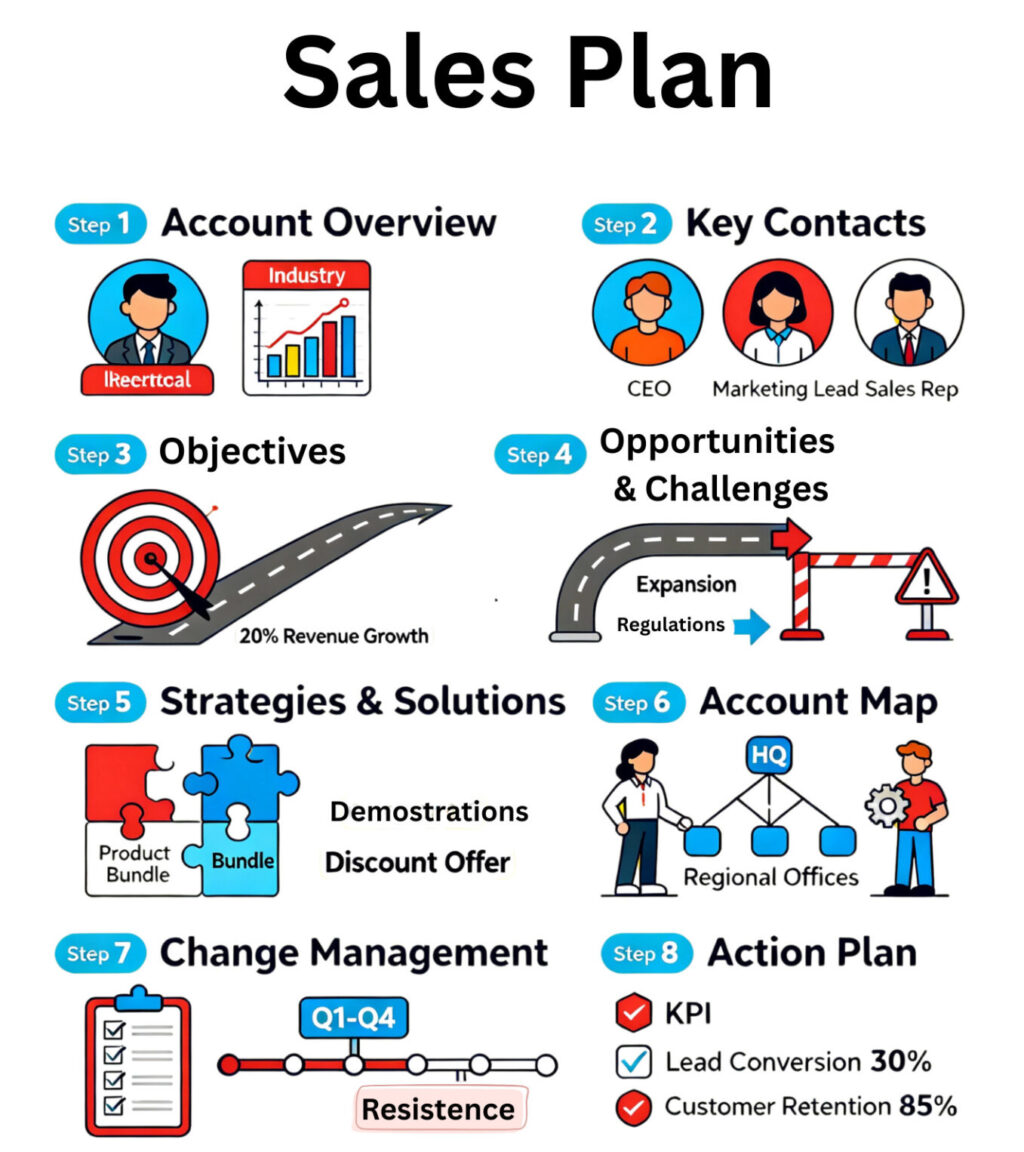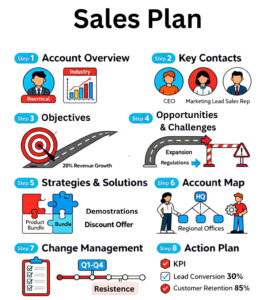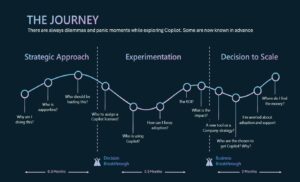Provide the goal and vision for your plan
A Sales plan for key accounts should include structured sections to guide discovery, opportunity identification, solution proposals, and execution.

Key Sections of a Sales Plan:
- Account Overview: Include client snapshot, industry details, revenue, relationship strength, and account history.
- Key Contacts: List decision-makers, influencers, and other stakeholders within the client organization.
- Objectives: Define top objectives or goals for the client, with aligned offerings and measurable success metrics.
- Opportunities & Challenges: Identify main issues, growth opportunities, and key obstacles the client faces.
- Strategies & Solutions: Propose tailored approaches and solutions, detailing how they align with the client’s goals and how success will be visualized after implementation.
- Account Map: Document an organizational chart of contacts, influencers, blockers, and champions to clarify internal dynamics.
- Change Management: Outline force-for-change and resistance factors, stakeholder involvement, training, and quick wins for early progress.
- Action Plan: Assign responsibilities, timelines, and KPIs for each strategic action, plus regular review and optimization schedules.
Account Overview
Company Basic Information: Company name, founding year, background and history, mission and vision statements, industry, target markets, company size (number of employees), annual revenue, and geographic locations.
Business Description: What products or services the company sells, key client segments, and general market position.
Financials: Key financial metrics such as revenue, profitability, business units, and total annual revenue potential.
Customer Objectives and Strategy: The client’s business goals, vision, strategy, key business initiatives, and challenges they face.
Organizational Structure: Key stakeholders, decision-makers, account mapping with roles, relationships, and influence within the organization.
Recent Performance and Trends: Business performance highlights, recent initiatives, market movements, competitive landscape, and industry trends impacting the client.
Current Engagement: The status and details of existing contracts, current budget/spend, ongoing projects, and renewals.
Opportunities and Whitespace: Potential areas for growth or expansion, gaps between client needs and current solutions, and untapped upsell or cross-sell opportunities.
Relationship Status: The health of current relationships, contact engagement levels, and customer satisfaction indicators.
Competitor Analysis: Key competitors the client faces and positioning within the market.
Objectives
For best practices on “Objectives” in a Sales Action Plan, recommended sources highlight the following:
- Use the SMART framework: objectives should be Specific, Measurable, Achievable, Relevant, and Time-bound. This ensures goals are clear, actionable, and trackable over time.
- Set clear, quantifiable sales goals aligned with overall business objectives, such as increasing revenue, market share, or customer acquisition within a defined period.
- Break large objectives into smaller, manageable milestones or sub-goals by product, region, or sales rep to maintain focus and motivation.
- Include different types of objectives such as revenue growth, customer acquisition, customer retention, sales efficiency, and win rate improvement.
- Prioritize and cascade objectives throughout the sales team, ensuring alignment and accountability at all levels.
- Use data and past performance analysis to inform realistic and ambitious objectives.
- Communicate objectives clearly to the sales team, soliciting input to foster ownership and practical feasibility.
Sources providing detailed frameworks and examples include Spotio’s 10-Step Sales Action Plan, Salesforce Action Plan documentation, and sales strategy guides from Salesdorado and Allego, which all emphasize structured, measurable, and aligned objectives within sales action plans
Opportunities & Challenges
For best practices on addressing “Opportunities & Challenges” in a Sales Action Plan, recommended sources emphasize:
- Begin with a thorough diagnosis that includes market, customer, and competitor analysis to identify opportunities and threats. This foundational step helps uncover key issues and priority challenges to address.
- Clearly articulate specific opportunities such as new market segments, product innovations, or customer needs gaps that can be leveraged for growth.
- Identify challenges or obstacles such as competition, sales process inefficiencies, customer objections, or changing market conditions that may hinder target achievement.
- Develop strategic responses and action plans tailored to overcoming challenges and seizing opportunities, balancing quick wins with longer-term initiatives.
- Use data and past performance to analyze where the sales funnel or process may be losing deals, focusing coaching and resources accordingly.
- Plan for continuous tracking and adjustment of actions based on outcomes and evolving market realities.
- Foster alignment between sales and marketing to better address challenges and capitalize on opportunities.
- Invest in training, technology tools, and motivational strategies to overcome identified challenges such as lead generation difficulties, objection handling, or competitive differentiation.
- Viewing objections and challenges as opportunities to improve value propositions or customer relationships enhances resilience and effectiveness.
Sources like Spotio’s 10-Step Sales Action Plan, HubSpot’s sales strategy articles, Salesdorado’s comprehensive SAP guide, Resilient Retail Club’s sales plan ideas, and Pure Blue Ocean’s sales challenge strategies provide detailed frameworks and actionable insights for this section of sales plans.
Strategies & Solutions
- Develop strategies that are specific, measurable, and adaptable, using frameworks like SMART goals to ensure focus and accountability.
- Customize solutions to meet the unique needs of target customers based on detailed account insights and buyer personas.
- Prioritize resource allocation including sales tools, marketing support, training, and technology to empower the sales team effectively.
- Define clear action steps and timelines for strategy execution, including ongoing monitoring and performance evaluation to allow rapid response to market or client changes.
- Incorporate quick wins alongside long-term initiatives to sustain momentum and demonstrate value early in the plan’s execution.
- Foster collaboration across sales, marketing, and product teams to ensure cohesive messaging and seamless customer experience.
- Leverage data, analytics, and customer feedback continuously to refine strategies and improve solution effectiveness.
- Ensure communication of strategies and solutions is clear, concise, and motivating to drive buy-in and execution discipline.
Sources highlighting these principles include Spotio’s sales action plan framework, HubSpot’s strategic sales guides, Salesforce’s sales strategy resources, and Atlassian’s sales strategy blog, all emphasizing structured planning, customer focus, measurable goals, and execution rigor.






